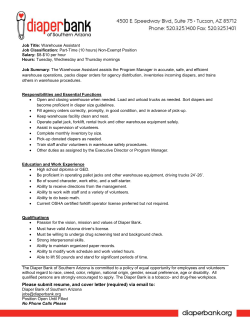
Diaper Rash
Diaper Rash Most babies get diaper rash, but it is usually not serious. Read on to find out more about what causes diaper rash and how to treat it. What is diaper rash? Diaper rash is any rash that develops inside the diaper area. In mild cases, the skin might be red. In more severe cases, there may be painful open sores. It is usually seen around the groin and inside the folds of the upper thighs and buttocks. Mild cases clear up within 3 to 4 days with treatment. What causes diaper rash? Over the years diaper rash has been blamed on many causes, such as teething, diet, and ammonia in the urine. However, we now believe it is caused by any of the following: • Too much moisture • Chafing or rubbing • When urine, stools, or both touch the skin for long periods of time • Yeast infection • Bacterial infection • Allergic reaction to diaper material When skin stays wet for too long, it starts to break down. When wet skin is rubbed, it also damages more easily. Moisture from a soiled diaper can harm your baby’s skin and make it more prone to chafing. When this happens, a diaper rash may develop. More than half of babies between 4 and 15 months of age develop diaper rash at least once in a 2-month period. Diaper rash occurs more often when • Babies get older—mostly between 8 to 10 months of age. • Babies are not kept clean and dry. •Babies have frequent stools, especially when the stools stay in their diapers overnight. • Babies begin to eat solid foods. •Babies are taking antibiotics, or in nursing babies whose mothers are taking antibiotics. When to call the pediatrician Sometimes a diaper rash needs medical attention. Talk with your pediatrician if •The rash does not look like it’s going away or gets worse 2 to 3 days after treatment. (See “What can I do if my baby gets diaper rash?”) • The rash includes blisters or pus-filled sores. •Your baby is taking an antibiotic and has a bright red rash with red spots at its edges. This might be a yeast infection. • Your baby has a fever along with a rash. •The rash is very painful. Your baby might have a skin condition called cellulitis. What can I do if my baby gets diaper rash? If your baby gets a diaper rash (and to prevent future diaper rashes) it’s important to keep the area as clean and dry as possible. Change wet or soiled diapers right away. This helps cut down how much moisture is on the skin. •Gently clean the diaper area with water and a soft washcloth. Use soap and water only if the stool does not come off easily. If the rash is severe, use a squirt bottle of water so you can clean and rinse without rubbing. • Pat dry; do not rub. Allow the area to air-dry fully. •Apply a thick layer of protective ointment or cream (such as one that contains zinc oxide or petroleum jelly). These ointments are usually thick and pasty and do not have to be completely removed at the next diaper change. Remember, heavy scrubbing or rubbing will only damage the skin more. •Avoid using wipes that can dry out the skin. The alcohol or perfume in many of these products can further irritate your baby’s skin. •Do not put the diaper on too tight, especially overnight. Keep the diaper loose so that the wet and soiled parts do not rub against the skin as much. •Use creams with steroids only if your pediatrician recommends them. They are rarely needed and may be harmful. • Check with your pediatrician if the rash — Has blisters or pus-filled sores. — Does not go away within 2 to 3 days. — Gets worse. Which type of diaper should I use? Diapers are made of either cloth or disposable materials. Cloth diapers can be washed after they get soiled and used again. Disposable diapers are thrown away after each use. If you choose not to wash cloth diapers yourself, you can have a diaper service clean them. If you do your own washing, you will need to presoak heavily soiled diapers. Keep and wash soiled diapers separate from other clothes. Use hot water and double-rinse each wash. Do not use fabric softeners or antistatic products on the diapers because they may cause rashes in sensitive skin. Research suggests that diaper rash is less common with the use of disposable diapers. However, what is more important than the type of diaper is how often it is changed. Whether you use cloth diapers, disposables, or both, always change diapers as needed to keep your baby clean, dry, and healthy. From your doctor Remember—never leave your baby alone on the changing table or on any other surface above the floor. Even a newborn can make a sudden turn and fall to the floor. The information contained in this publication should not be used as a substitute for the medical care and advice of your pediatrician. There may be variations in treatment that your pediatrician may recommend based on individual facts and circumstances. The American Academy of Pediatrics is an organization of 60,000 primary care pediatricians, pediatric medical subspecialists, and pediatric surgical specialists dedicated to the health, safety, and well-being of infants, children, adolescents, and young adults. American Academy of Pediatrics Web site—www.aap.org Copyright © 2007 American Academy of Pediatrics, Updated 6/07
© Copyright 2025













